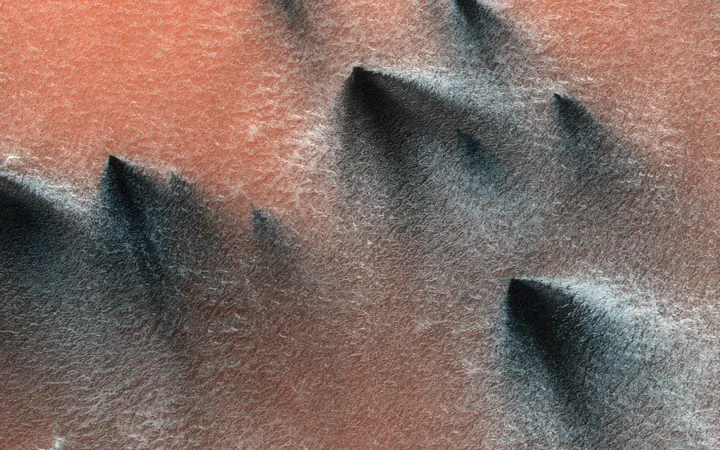
Unveiling Mars' Mysterious CO2 Geysers: Nature's Own Artwork
2025-01-30
Author: John Tan
Introduction
Mars, often characterized as a cold and desolate planet, harbors unique and stunning features that set it apart from Earth. One of the most intriguing natural phenomena on the Martian surface are the carbon dioxide geysers, which paint a picture of beauty shaped by the planet's harsh conditions.
Atmospheric Conditions
Mars possesses a thin atmosphere, with approximately 95% of it composed of carbon dioxide. Each Martian winter, the temperatures plunge low enough for CO2 to freeze, forming a thick veneer over the polar regions, lying dormant for long months. However, as spring approaches and temperatures gradually rise, changes begin beneath this solid icy crust.
The Eruption Process
Sunlight filters through the translucent layer of frozen CO2, warming the ground underneath. This warming prompts the frozen carbon dioxide to sublime, transitioning from solid to gas. Trapped under the icy layer, the accumulating gas seeks a way to escape, resulting in spectacular geyser eruptions that can spout dark material across the Martian surface.
Imagery and Impact
In spectacular imagery captured by NASA’s HiRISE camera aboard the Mars Reconnaissance Orbiter, these geysers can be seen in action. Some eruptions are so powerful that they can give rise to dark spots that span up to 1 kilometer in diameter and can shoot debris at speeds of up to 160 kilometers per hour. These dynamic eruptions sometimes create formations that resemble spiders, classified as araneiform terrain or "spider terrain." This peculiar landscape often presents in striking clusters, lending a wrinkled appearance to the icy surface.
Scientific Exploration
NASA scientists have engaged in laboratory simulations to replicate the formation of these spider-like structures, striving to unlock the secrets behind their genesis. “The spiders are strange, beautiful geologic features in their own right,” said Lauren McKeown from NASA’s Jet Propulsion Laboratory, emphasizing the aesthetic quality of these Martian formations.
Understanding the Mechanisms
The mechanisms behind the CO2 geysers are explained by what is known as the Keiffer model, developed by Hugh Keiffer and his colleagues in their groundbreaking 2006 paper published in Nature. They elucidate how the seasonal ice cap acts as a translucent barrier that sublimates CO2, leading to gas buildup underneath. Eventually, this high-pressure gas ruptures the ice, creating venting jets that propel grains outward, generating the characteristic spots and eroding channels.
Contrast With Earth
In a fascinating contrast to Earth's scenic beauty, the processes giving rise to these geysers on Mars are not only scientifically significant but also artistically unique, as they yield features with no counterpart in our own planet's geological landscape. As the authors of the 2006 paper succinctly put it, “These processes are unlike any observed on Earth,” suggesting that the red planet holds its own enigmatic allure, redefining our understanding of natural beauty in the cosmos.
Conclusion
Indeed, while Earth continues to inspire poets and dreamers alike, the captivating patterns created by CO2 geysers on Mars remind us that the universe may hold wonders beyond our imagination, waiting to be explored and understood.

 Brasil (PT)
Brasil (PT)
 Canada (EN)
Canada (EN)
 Chile (ES)
Chile (ES)
 Česko (CS)
Česko (CS)
 대한민국 (KO)
대한민국 (KO)
 España (ES)
España (ES)
 France (FR)
France (FR)
 Hong Kong (EN)
Hong Kong (EN)
 Italia (IT)
Italia (IT)
 日本 (JA)
日本 (JA)
 Magyarország (HU)
Magyarország (HU)
 Norge (NO)
Norge (NO)
 Polska (PL)
Polska (PL)
 Schweiz (DE)
Schweiz (DE)
 Singapore (EN)
Singapore (EN)
 Sverige (SV)
Sverige (SV)
 Suomi (FI)
Suomi (FI)
 Türkiye (TR)
Türkiye (TR)
 الإمارات العربية المتحدة (AR)
الإمارات العربية المتحدة (AR)